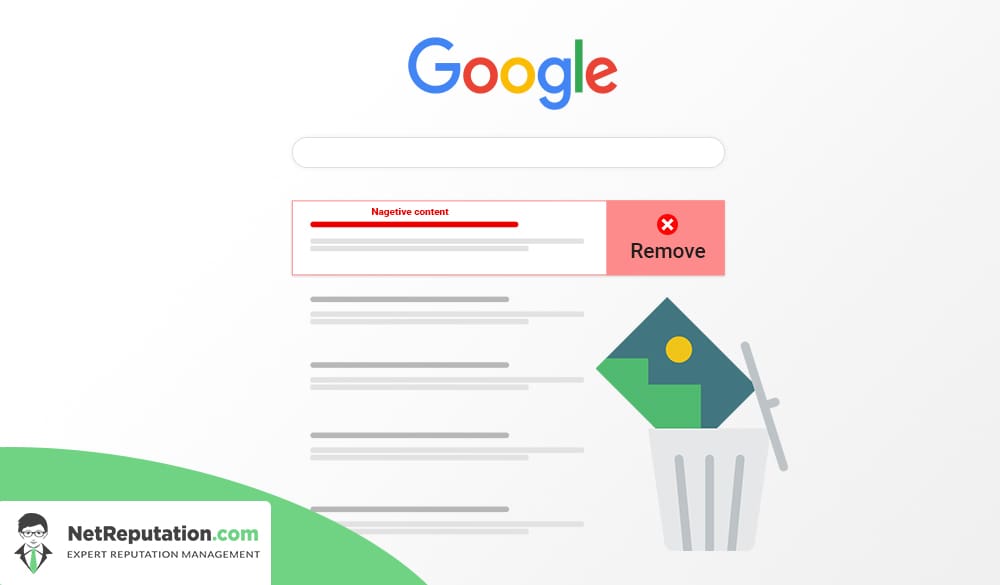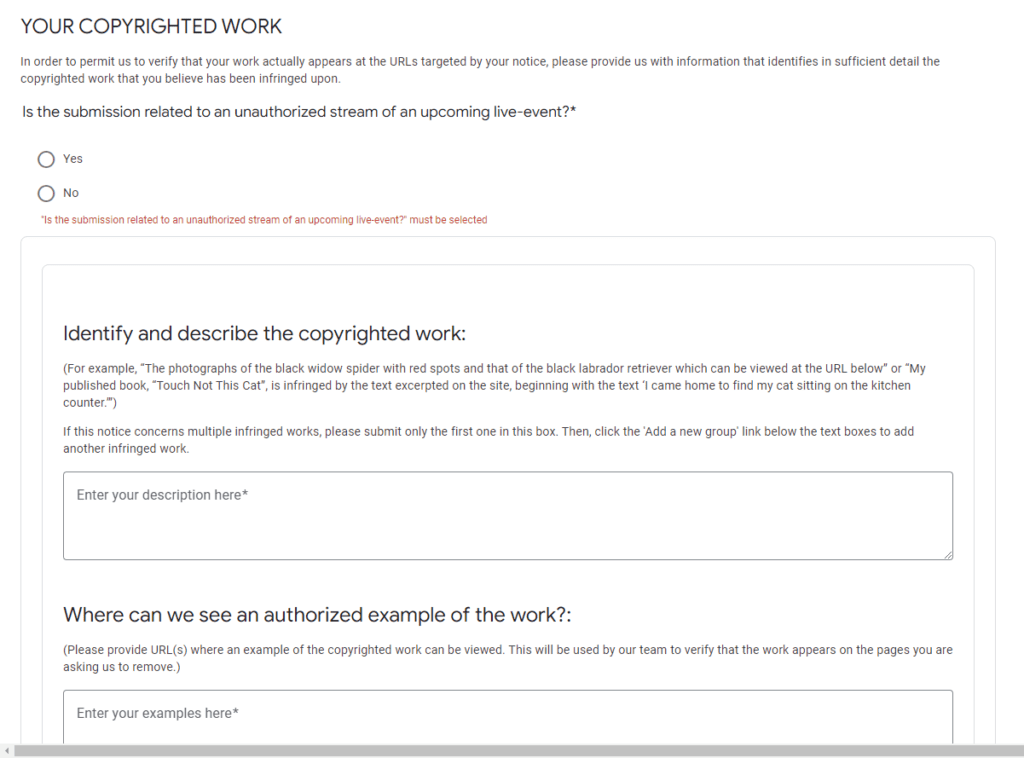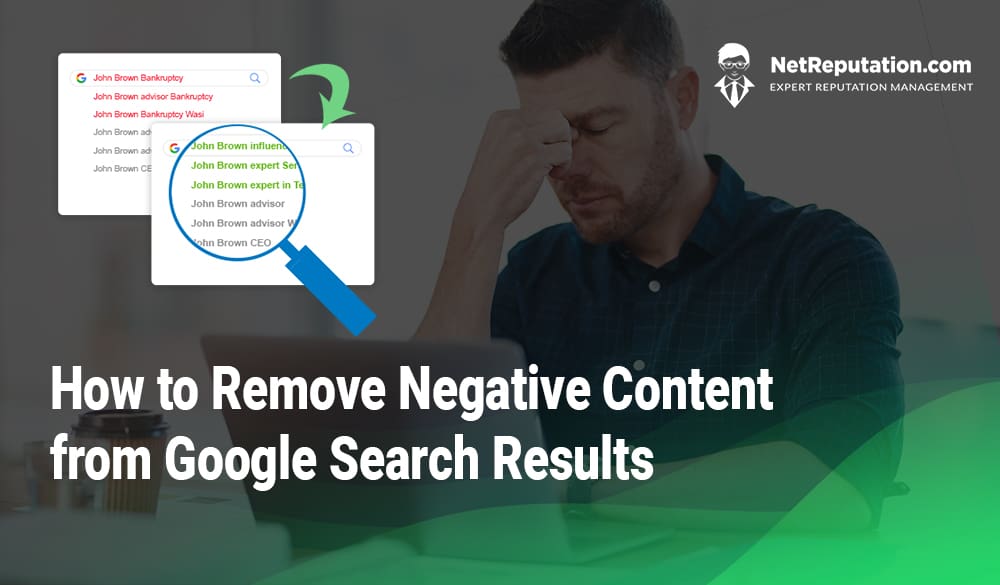Remove negative content from Google with our comprehensive guide to reputation management strategies.
Negative content posted to the web can harm one’s reputation by spreading quickly on the internet, especially on Google search results.
Because your online reputation is tied directly to the quality and quantity of search results, the removal of such content has become crucial.
Strategies include legal action, SEO, and content creation, but it can be challenging and may require professional assistance.
Our guide provides all the answers you’ll need to make smart decisions, helping you to remove negative content from Google search results once and for all.
Get started with your free online reputation evaluation today
Why Is Removing Negative Content So Important?
Removing negative content from Google search results is important because it can have significant effects on personal or professional reputations. Here are some reasons why:
- First Impressions: Google search results are often the first impression people have of a person or business. Negative content in the search results can influence people’s perceptions and potentially harm their reputation.
- Credibility: Negative content can reduce credibility and trustworthiness. People are less likely to trust or do business with someone who has negative search results.
- Opportunities: Negative content can lead to missed opportunities, such as job offers or business deals. Employers and clients often research people before making decisions, and negative search results can be a deal-breaker.
- Psychological Impact: Negative content can have a psychological impact, leading to stress, anxiety, and even depression. It can also harm personal relationships and social interactions.
- Long-lasting Impact: Negative content on Google search results can have a long-lasting impact. Even if the content is removed, it can still be archived and accessed through various sources, such as online archives or web caches.
Whether you are an individual or a business owner, your online reputation is critical for achieving your goals. That’s why removing negative content from Google search results is important to maintain a positive reputation and protect oneself from potential reputational and financial harm.
Ways to Remove Negative Search Results from Google
There are several strategies you can take to remove negative content from Google. Let’s take a look at each of them in more detail below.
Request the Content Be Removed From Google
Google provides a process for requesting the removal of specific types of content from its search results, but it’s important to note that it’s not always possible to have content removed.
Google’s removal policies are designed to balance the right to free expression with the need to protect individual privacy and digital reputation.
In general, Google may consider removing content that contains sensitive personal information, such as Social Security numbers, bank account information, or intimate images without consent. It may also consider removing content that is illegal, such as content that infringes on copyright or contains hate speech.
It is important to note that Google is unlikely to remove content just because it’s negative or harmful to a person’s reputation. If you believe the negative content violates specific content policies, you can submit a removal request for review by Google’s team.
Even if Google does remove content from its search results, it may still be accessible through other means, such as social media or other websites.
Contact the Author or Publisher
It is possible to contact a webmaster or site owner to request the removal of negative content from their website. In many cases, the webmaster or site owner may be willing to remove the content – such as embarrassing mugshots or other unflattering information – if it violates their site’s policies or if they believe it’s harmful.
When contacting a webmaster or site owner, start by identifying the specific content you want removed and explain why it’s harmful to your reputation or privacy. Provide any evidence or documentation that supports your request, such as court orders or legal notices. Be clear and concise in your request and avoid making threats or using aggressive language.
It’s important to note that webmasters and site owners are not legally required to remove content unless it violates the law or infringes on someone else’s rights. However, many webmasters and site owners are willing to work with individuals to address negative content and maintain a positive online environment.
If your request is denied or ignored, you may need to explore other options, such as legal action or reputation management services.
Use Copyright Law to Remove Negative Content from Search
Copyright law may be used to get negative content removed from Google or a website if the content infringes on your copyrighted material. Here are the steps you can take:
- Identify the infringing content: Determine which content on Google or a website is infringing on your copyrighted material. The content must be a verbatim or substantially similar copy of your original work.
- Contact the website owner: Contact the website owner or webmaster and provide evidence of your copyrighted material and the infringing content. Request that the infringing content be removed and provide a deadline for action.
- Send a DMCA takedown notice: If the website owner or webmaster does not remove the infringing content, you can send a DMCA (Digital Millennium Copyright Act) takedown notice to the website’s ISP (Internet Service Provider) or hosting provider. The DMCA takedown notice must include specific information, such as your contact information, the location of the infringing content, and a statement that you have a good faith belief that the content is infringing.
- Wait for response: The ISP or hosting provider will review your DMCA takedown notice and, if it meets the requirements, will remove the infringing content. The website owner or webmaster may also choose to file a counter-notice to dispute the takedown.
- Consider legal action: If the infringing content is not removed after the DMCA takedown notice, you may need to consider legal action against the website owner or webmaster. This can include filing a lawsuit for copyright infringement and seeking damages.
Copyright law can only be used to remove content that infringes on your copyrighted material. It cannot be used to remove content that is negative or harmful to your reputation, unless it contains copyrighted material that you own.

How Do You Report Copyright Infringement to Google?
To report copyright infringement to Google, you can use the Google DMCA (Digital Millennium Copyright Act) reporting tool. Here are the steps to follow:
- Go to the Google DMCA reporting tool: Visit the Google DMCA reporting tool webpage, which can be found at https://www.google.com/webmasters/tools/dmca-notice.
- Fill out the form: Fill out the online form with your contact information, the URL of the infringing content, and information about your copyrighted material. You will also need to provide a statement that you have a good faith belief that the use of the material is not authorized by the copyright owner.
- Submit the form: Click the “Submit” button to submit the DMCA takedown notice to Google.
- Wait for response: Google will review your DMCA takedown notice and, if it meets the requirements, will remove the infringing content from its search results and from any Google services that host the content.
It’s important to note that submitting a false or misleading DMCA takedown notice is illegal and can result in legal action against you. Therefore, it’s crucial to ensure that the content in question does, in fact, infringe on your copyrighted material before submitting a DMCA takedown notice.

Google’s copyright infringement reporting tool
Can Search Results Be Suppressed?
Content suppression is a strategy used to mitigate the negative impact of online content that cannot be removed from Google search results.
In some cases, negative content such as negative reviews, news articles, or social media posts may be protected by free speech or other legal rights, making removal impossible.
Content suppression involves creating and promoting positive content to push the negative content further down in search results, making it less visible to people searching for information about an individual or business.
How Suppression Works
Content suppression involves creating and promoting positive content to push down negative content that cannot be removed from Google search results.
The process of content suppression requires identifying the negative content, creating and optimizing positive content, promoting it, and monitoring the results. In our experience, content suppression is an ideal solution for negative articles, records, or images that cannot be removed through traditional means.
Content suppression is a complex and ongoing process that involves various strategies such as search engine optimization, social media management, and online reputation management. The goal is to ensure that positive content appears higher in search results, making the negative content less visible.
How to Bury Negative Search Results
Burying negative search results on Google involves using content suppression strategies to push negative content down in search results. When done correctly, negative results can be pushed to the second or third page of search engine results pages (SERPs). Here are some steps you can take:
- Create positive content: Create positive content that highlights the individual or business’s strengths, such as blog posts, social media profiles, and press releases. The content should be high-quality, relevant, and optimized for search engines.
- Optimize positive content: Use search engine optimization (SEO) strategies to optimize positive content, such as using keywords and meta tags that are relevant to the audience. This helps to improve the search engine ranking of positive content.
- Promote positive content: Promote positive content through social media, influencer outreach, and link building. This helps to increase visibility and improve the search engine ranking of positive content.
- Monitor results: Monitor search engine rankings of both positive and negative content and adjust the content and promotion strategy as needed.
Burying negative search results on Google can be a time-consuming and ongoing process, and it may not always be possible to completely remove negative content. However, with consistent effort and an effective content suppression strategy, it’s possible to push negative content down in search results and improve the overall online reputation of the individual or business.
Can negative SEO suppress a search result?
Negative SEO is a black hat practice where someone intentionally uses unethical tactics to harm the search engine ranking of a website or web page. While negative SEO can potentially harm a website’s ranking, this shady practice often does more harm than good. In our experience, there are far better choices, including the tips and strategies above, to remove negative content from Google.
Negative SEO tactics typically involve using techniques such as creating spammy backlinks, keyword stuffing, and cloaking. These tactics can lead to Google penalizing the website, but they are unlikely to affect the ranking of the negative search result.
Because negative SEO is an unethical practice, it can result in serious consequences, such as legal action, penalties, and further damage to your online reputation. It is not recommended to use negative SEO as a strategy for suppressing negative search results.
Manage Your Reputation Using a Professional Service
When you’re faced with negative content in Google search results, your online reputation is at risk.
While you can work to remove negative content from Google on your own, this process can be frustrating, not to mention time-consuming. For content that can’t be removed outright, content suppression strategies add another layer of complexity to the issue.
In these cases, online reputation management companies can be a valuable asset. As a leader in online reputation management services for businesses and individuals, NetReputation uses proven strategies to remove harmful content from search results or suppress it with positive, engaging content.
Key Takeaways
Now that we’ve learned about negative content removal and content suppression, here are some of the most important points to consider:
- Negative content can harm personal or professional reputations, and it’s important to address it proactively.
- Removing negative content from Google search results may not always be possible, but content suppression strategies can be effective in burying negative content.
- Content suppression involves creating and promoting positive content to push negative content down in search results.
- Negative SEO is an unethical practice that can harm the search engine ranking of a website, but it’s unlikely to be effective in suppressing a negative search result.
- Strategies for removing negative content or suppressing it include legal action, search engine optimization, content creation, and online reputation management.
- It’s important to approach requests for content removal in a respectful and professional manner and to be prepared to explore legal options if necessary.
- Content suppression is an ongoing process that requires consistent effort and monitoring to ensure that positive content outranks negative content in search results.
Negative content removal and content suppression are important strategies for protecting personal and professional reputations in the digital age. By taking a proactive approach and using effective strategies, it’s possible to mitigate the impact of negative content and maintain a positive online presence.
Negative Content Removal FAQs
Here are some of the most common questions fielded by the negative content removal team at NetReputation:
What kind of negative content can pop up on search results?
Negative online content can take many forms, including:
- Negative news articles
- Arrest reports and criminal histories
- Mugshots
- Negative reviews on Google or hundreds of other popular review sites
- Negative comments on social media
- Negative blog posts
Each of these types of negative information can damage your online reputation.
How long does it take for Google to remove outdated content?
There is no fixed timeline for Google to remove outdated content from its search results. The time it takes for Google to remove outdated content can vary depending on several factors, including the type of content, the website hosting the content, and the frequency of Google’s crawls of the website.
In general, Google’s crawlers periodically revisit web pages to update their index, so outdated content may be removed from search results when Google next crawls the website. However, there is no guarantee that outdated content will be removed, even if it’s no longer relevant or accurate.
Google also provides a process for requesting the removal of outdated content from search results. This includes submitting a request through the Google Search Console or using the public URL removal tool. Google will review the request and determine whether the content should be removed from its search results.
Should I hire a Lawyer to remove negative content?
Whether or not you should hire a lawyer to help you with removing negative content from Google depends on the specific circumstances of your case. In some cases, a lawyer may be able to provide valuable assistance in navigating legal issues related to negative content, such as defamation, invasion of privacy, or copyright infringement.
If you believe that the negative content is false, defamatory, or infringes on your legal rights, it may be a good idea to consult with a lawyer to discuss your options. A lawyer can help you understand the legal requirements for removing negative content, such as sending a cease and desist letter, filing a lawsuit, or submitting a DMCA takedown notice.
When evaluating the need for a content removal attorney, it’s important to note that legal services can be expensive. In some cases, online reputation management firms may be able to assist you with content removal and content suppression services.
Contact NetReputation Today
Negative content in online search results can have a devastating impact on your digital reputation.
If you’re struggling with negative content, NetReputation can help. Our team of content removal professionals use proven strategies to get negative content removed from Google permanently. If content removal isn’t possible, content suppression provides a solution to get negative content off the first page of Google results.
Call our content removal team today at 844-461-3632 or complete the form below to begin your free reputation analysis.
